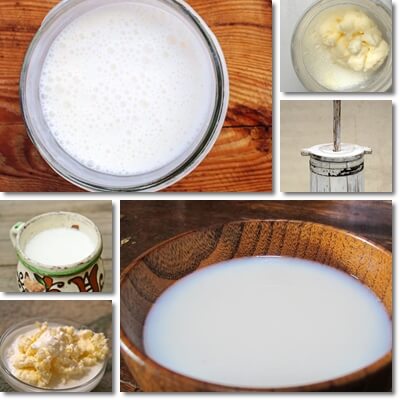What is buttermilk? Buttermilk is a name given to a variety of fermented milk-based products. Originally, buttermilk referred to the liquid left over after extracting butter from fermented whole milk or cream, hence the name. Nowadays, the term may denominate several sour, milk-based products obtained through addition of special bacteria cultures to previously pasteurized whole or reduced fat milk. It may also refer to addition of a food acid like acetic acid from vinegar or citric acid from lemon juice to unpasteurized milk. Today’s article is concerned with the nutritional properties and health benefits of traditional buttermilk, obtained through the method of churning either fermented whole milk or cream.
How is buttermilk made? The traditional method involved leaving fresh whole milk in a cool place for a day or two to naturally ferment and sour, after which it would be added to a manual churn and agitated until the fat from the milk separated and rose to the surface. The same process would be applied to milk cream. The fat that rose to the surface was the butter and it would be collected with a wooden spoon into a bowl. The remaining liquid, which was typically more like a sour whey than milk, was called buttermilk and would be used as food, functional food or for baking purposes.

What does buttermilk look like? Traditional buttermilk, obtained as a by-product of manual butter production, is milky white, liquid but slightly thicker than regular milk, with fine bubbles. It may be perceived as creamier in texture than whole milk, but in fact is just slightly thicker. Commercial buttermilk (usually cultured buttermilk) is milky white, liquid but typically thicker and creamier than traditional buttermilk and than whole milk (it’s creamier because the milk used maintains some of its fat content). Acidified buttermilk (which is really a soured milk, not real buttermilk) is white in color, with a varying texture, both liquid and clumps of coagulated milk, similar to set yogurt. Under the action of various food acids, it may thicken almost as much as a set yogurt.
What does buttermilk taste and smell like? Traditional buttermilk is sour, acidic tasting, tangy, sharp, with a similar, rather strong, sour milk aroma. Commercial varieties are also acidic-tasting, but milder and usually creamier in texture, depending on the fat content of the milk used to produce the buttermilk. Various fine flavor notes may be observed depending on the bacteria cultures employed. Home-made cultured buttermilk will often taste like a sour yogurt (usually sour yogurt is added to the milk because it contains live lactic acid bacteria which work as a starter culture and is a cost-effective option).Home-made acidified buttermilk (which is really a buttermilk substitute) is sour, acidic, but won’t taste like the acidic agent used to make it (vinegar or lemon juice) unless you add too much of it.
Buttermilk nutrition
Traditional buttermilk nutrition is difficult to determine first of all because the nutrition of the whole milk used to make the butter and buttermilk is unknown (milk from one or more animals from the same day or different days may be used, diet particulars determine the final nutritional value of the milk, whole fat or reduced fat affect nutritional status etc.). Secondly, because traditional buttermilk is an artisanal food and the production process may vary greatly from one manufacturer to another, likely resulting in more or less fat and other nutrients from the milk being extracted for butter and thus an undetermined nutritional value for the buttermilk too. As such, the final nutritional value of traditional buttermilk is, well, unknown. Commercial varieties may also have varying nutritional profiles, although most products are standardized.

What is known about traditional buttermilk nutrition compared to commercial variants of the product is that it contains the following relative amounts of macro and micronutrients:
1) Lower energetic value, up to 30% less calories than whole milk (estimated at 40 kcal/100 g).
By comparison, commercial cultured buttermilk from whole milk (usually cow’s milk) has the same energetic value as whole milk, about 60 kcal/100 g. Low-fat commercial cultured buttermilk may contain an estimated of 40 kcal/100 g, similar to the traditional product.
2) Good amounts of protein: Traditional buttermilk maintains roughly the same protein content as whole milk: 3.2 to 3.3 g of protein/100 g. Commercial cultured varieties have the same protein content.
3) Low in fat. Traditional buttermilk is typically very low in fat as most of the fat is extracted as butter. Commercial cultured varieties from whole milk maintain the whole fat content of the milk, which is typically 3.2 to 3.3 g of fat per 100 g. Commercial cultured buttermilk made from low-fat milk has about 1 g of fat per 100 g.
4) Fat-soluble vitamins: Because traditional buttermilk has almost all the fat extracted as butter, fat-soluble vitamins content is extremely low for vitamins A, D and E and almost nonexistent for vitamin K, for example. As a side note, because buttermilk is a prebiotic, it contributes to healthy populations of gut bacteria and this, in turn, helps the body produce vitamin K itself.
By comparison, commercial cultured buttermilk from whole fat milk should maintain the initial values for fat-soluble vitamins A, D, E and K as found in the milk. Nevertheless, not all milk has the same nutrition, so amounts may vary slightly too between different brands. Commercial buttermilk from reduced fat and low fat milk has less of these vitamins, unless added through fortification.
5) Other vitamins and minerals. Traditional buttermilk should maintain all the water-soluble vitamins in the whole milk, including B vitamins like vitamins B1, B2, B5 and B12, biotin. Initial amounts of minerals such as calcium, iodine, magnesium, potassium, selenium, phosphorus, sodium and zinc may also be maintained almost entirely. By comparison, commercial varieties may be enriched with these vitamins and dietary minerals, resulting in a potentially superior nutrition (choice of nutrient fortification belongs to producers and is regulated by government-issued standard nutritional recommendations). For more information, check the label.
Buttermilk health benefits
How is buttermilk good for you?
1) Natural probiotic. Is buttermilk a prebiotic? Yes, it is. Traditional and commercially cultured buttermilk contain live lactic acid bacteria (probiotics) which have beneficial effects for the human digestive system. These bacteria contribute to beneficial gut flora populations, driving many wonderful health effects, from regulating metabolism, digestion, nutrient absorption and transit to boosting immunity. Read more about how gut bacteria affects your health.
2) Benefits for digestion. Buttermilk is good for the digestive system because it is a probiotic. Probiotics help maintain a healthy gut bacteria ecosystem. And healthy gut bacteria help us digest food better, absorb the nutrients in it more efficiently, regulate transit time, helping relieve constipation naturally and may even lower the risk of colon cancer.
3) Strengthens the immune system. Eating probiotic foods like buttermilk or soured milk, yogurt, kefir and cheeses contributes to healthy gut bacteria populations. The very presence of healthy gut bacteria populations inhibits the growth of pathogenic bacteria and thus contributes to better immunity.
4) Good for weight loss. Traditional and commercial low fat buttermilk are good for losing weight. Both provide essential nutrients and beneficial probiotic bacteria for regulating metabolic processes as well as supply less fat and less calories than other dairy and good amounts of protein for building muscle and providing satiation, thus curbing hunger. They are a good food to consider for losing weight if the acidity doesn’t elicit side effects.
5) Benefits for brain and nervous system. As a source of protein containing both essential and non-essential amino acids, buttermilk helps regulate the production of neurotransmitters for the brain and, implicitly, important aspects of nervous system activity. Benefits may extend over mood, appetite, sleep, attention and learning. Moreover, as a source of vitamin B12, it helps maintain the integrity of the protective coating surrounding nerve cells; degradation of this protective coating is considered a risk factor for degenerative diseases like multiple sclerosis and Alzheimer’s disease.
6) Potentially good for constipation. A small, but regular intake of buttermilk can improve digestive health thanks to its probiotic properties, resulting in better transit and constipation relief. Constipation relief is also one of the main benefits of buttermilk for women as they are more likely to experience transit problems than men.
7) Cardiovascular benefits. Buttermilk contains potassium known for its excellent blood pressure-lowering properties as well as magnesium for arrhythmia. Preliminary studies consider short term consumption to be good for lowering blood pressure in healthy individuals.
8) Benefits of buttermilk for skin. The natural fats in commercial culture, full fat buttermilk moisturize skin, the water hydrates it, while the lactic acid helps improve appearance of uneven skin and acts as a mild exfoliating agent. After trying it myself, I have found it helps achieve softer skin and a more luminous complexion. So if you were wondering what to do with leftover buttermilk, know that you can use it as a skin mask, either alone or with other rejuvenating ingredients like honey, for example.
Buttermilk side effects and health risks
1) Acid reflux. Because it’s sour, acidic, buttermilk may cause or worsen an existing acid reflux. Symptoms may include regurgitation of gastric juices, bad, acidic or metallic taste in the mouth, heartburn, stomach discomfort and even insomnia. Drinking buttermilk at night is especially bad for you because chances are you will regurgitate the fermented milk and experience severe acid reflux.
2) Stomach air, bloating, flatulence, abdominal cramps. These side effects are more likely to occur if you drink too much buttermilk, at once or every day for a long time, have an existing gastrointestinal disorder like gastritis or acid reflux disease or are severely lactose intolerant.
3) Loose stools and diarrhea. Often caused by a reaction to lactose or by a high intake (and being a fermented product, it affects digestion shortening transit time).
Buttermilk and lactose explained. Bacteria ferment the sugar lactose in milk and convert it into lactic acids (hence the acidic taste of buttermilk and other fermented milk products). This leaves buttermilk with less lactose that regular milk. Some people with lactose intolerance may be able to drink small amounts of buttermilk without side effects, but others with react even to limited amounts and experience severe side effects like bloating, flatulence, loose stools and diarrhea.
